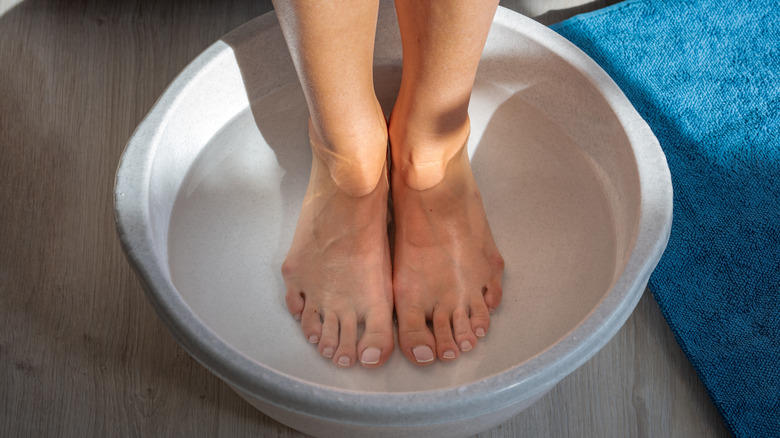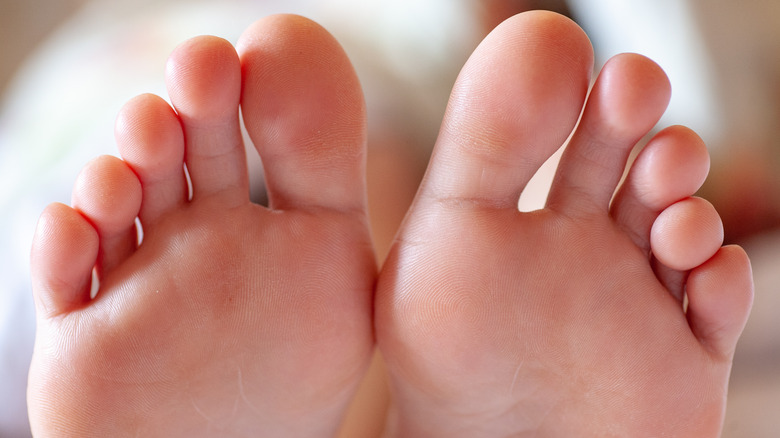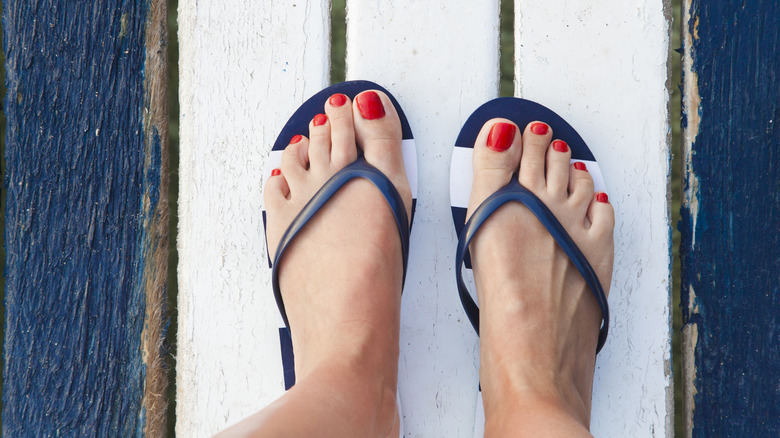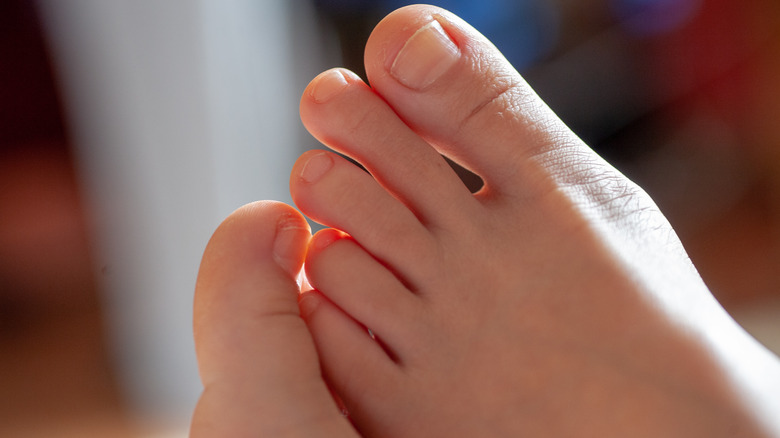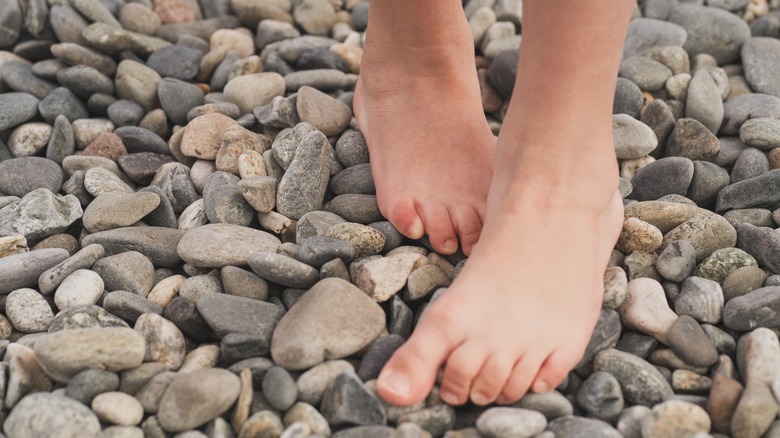What The Shape Of Your Foot Says About Your Ancestry
Finding out about your ancestry can be equal parts interesting, illuminating, and unexpected. With the rise of genealogical DNA tests like Ancestry and 23andMe, people are more cognizant than ever about their genetic makeup and origins. Per Business Insider, a whopping 26 million people world-wide took at-home DNA tests in 2019, when in 2015 just 1.5 million people did so. As explained by Globe News Wire, DNA testing isn't stopping anytime soon, with a projected 12.25% annual growth rate. People continue to be fascinated by their genetic makeup, especially when thinking about genealogy.
Today more than ever before, genetic makeup doesn't necessarily coincide with birthplace. While most people of ancient history could trace back their ancestors to the same place they called home, few can do the same in 2021. Even if you were born in Philadelphia or San Diego, you might trace your forefathers back to Ireland, Nigeria, China, Italy, or India, even if you never knew you were connected to those places. While that's all well and good, and definitely makes for an interesting day checking out your results (not to mention fun conversation at the dinner table), what's anyone to do once their DNA test is over with? If you're interested in examining your ancestry further, we present you with another alternative: the shape of your foot. Unexpected? Maybe. But the results are actually surprisingly accurate.
Egyptian foot shape
The Egyptian foot shape is one of the most common in the world. As explained by Atlas Bio Med, Egyptian toes form a perfect ladder from big toe to little toe, decreasing in length with each step and resembling a 45-degree angle. This makes it the "classic" foot shape everyone thinks of when they first picture a foot, and it is often seen portrayed in traditional paintings and sculptures. Yes, if you have the Egyptian toe shape you share a trait with "The Thinker" or "David." What does it mean when it comes to your genetics?
As expected, having an Egyptian toe shape might mean you can trace your ancestry back to ancient Egypt. More specifically, this could mean you come from the Egyptian population that was found in the ancient world around the Nile, Northern Africa, and Arabia (via Atlas Bio Med). According to Ancestral Findings, this shape is regarded as one of the most aesthetically pleasing out there, and is seen in all kinds of art throughout history, especially that of ancient Egypt. As if that weren't enough (per Atlas Bio Med), studies show that people with Egyptian feet are less likely to deal with ingrown toenails, and that they're superb for balance.
Greek foot shape
Next up, the Greek foot, or the second-most common toe shape. According to Atlas Bio Med, the "flame foot" is characterized by a second toe that's longer than all other toes on the foot, including the big toe. Moreover, the third, fourth, and fifth toes all angle downwards, just like the Egyptian foot. This shape has been similarly idealized throughout history, appearing in classic works of art, especially that of the Greeks. The Greek foot shape is often seen in ancient statues originating from that country, such as the "Venus de Milo" or the "Discobolus." This would suggest that the Greek foot shape was actually quite common throughout the region at the time.
Even more? According to Podexpert, a study showed that around 46% of Greeks have this kind of toe shape, while it can be seen on only 5% of the rest of the population. This supports the idea that foot genealogy isn't a pseudoscience, as some claim, even though it will never paint an exact picture of your DNA.
Moreover, apart from pointing to the land of Hercules and Athena, this shape means you carry a recessive trait for a longer second toe on your X chromosome. Even more, podiatrists call the phenomenon Morton's Toe, which some studies have shown may improve athletic ability, but can also cause an increase in foot pain (via Weird World).
Celtic foot shape
The Celtic toe shape is similar to Greek feet because it also features a second toe that is longer than the rest. It also has several differences: The big toe is short but very round and wide, the third toe is the same height as the big toe, and the fourth and fifth toes are shorter and equal in length (via Ancestral Findings). A complex toe shape, this foot style is thought to represent a powerful, strong personality. But what does it mean about your genetics?
As explained by Atlas Bio Med, this foot shape is thought to come from Western Europe, specifically Britain and Ireland, where this toe shape is most common. This also makes sense territorially, because the Celtic foot is a perfect blend of Greek feet, with their long second toes, and the slightly stockier, bulkier Germanic toes. This shape is so intricate that it might indicate that there isn't just one Celtic group, and that it is in fact made up of several different genetic subgroups. This dovetails with a recent theory that people from places like Scotland, Wales, and Ireland all have very different genetic origins.
Roman foot shape
The Roman foot shape is a more classic toe style that's often revered in traditional ancient Roman artwork. You have this shape if your first three toes (including your big toe) are equal in length, but your fourth and pinky toes are shorter and around the same length as each other. You can find this toe shape on famous Roman sculptures like "Augustus from Prima Porta" and "Marble Statue of a Wounded Amazon." This would lead many to believe that ancient Romans generally had this kind of toe shape.
As Atlas Bio Med reports, around 25% of people in the world have this toe shape, which makes sense when you think that the Roman Empire conquered about 21% of the world's population in their heyday in the early second century (via History Hit). These foot shapes are also seen as fit for warriors because of the Romans' military prowess, and for being wider and robust. Just like many a Roman emperor, if you have this toe shape, you might traverse places far and wide in search of adventure, might be especially athletic, and best of all, usually do not suffer from foot pain like those with Greek feet. Genetically, those with Roman feet might be able to trace their origins back to Europe and Northern Africa.
German foot shape
The German foot shape is one of the rarest of toe styles that reminds many people of the much more common Egyptian foot. For Germanic toes, while the big toe is the largest, the other four toes are much smaller and are all exactly the same size. Instead of following an angular progression like Egyptian feet or Greek feet, the other four toes are precisely leveled with each other (via Atlas Bio Med). Plus, this shape is usually stockier and bulkier, reminding many people of Celtic feet without the longer second toe. This is actually quite logical, since Celtic and Germanic peoples have a similar geographic orientation.
While Egyptian, Greek, and Roman feet are seen as the hallmark shapes often found in classical art, German feet are similar to the Celtic shape in sometimes being ignored artistically. As per Ancestral Findings, back in the ancient world, the "Germans" weren't just one group — they actually included several different peoples, similar to the Celts and the Egyptians. Saxony, Prussia and Bavaria were all different countries, and it was actually the Romans that decided to group them under the label of "Germans." For this reason, tracing this foot shape back to the Germans is a bit more complex, but may still point you to that area of the world.
